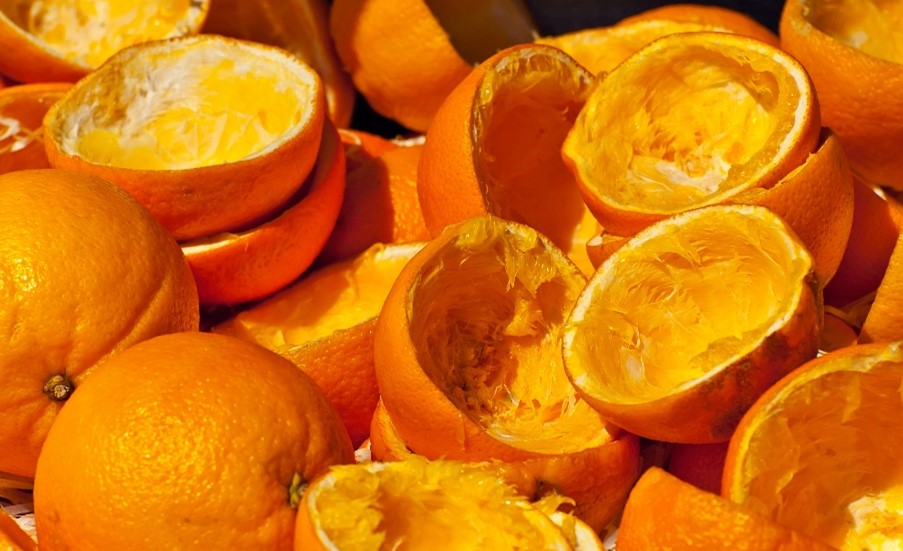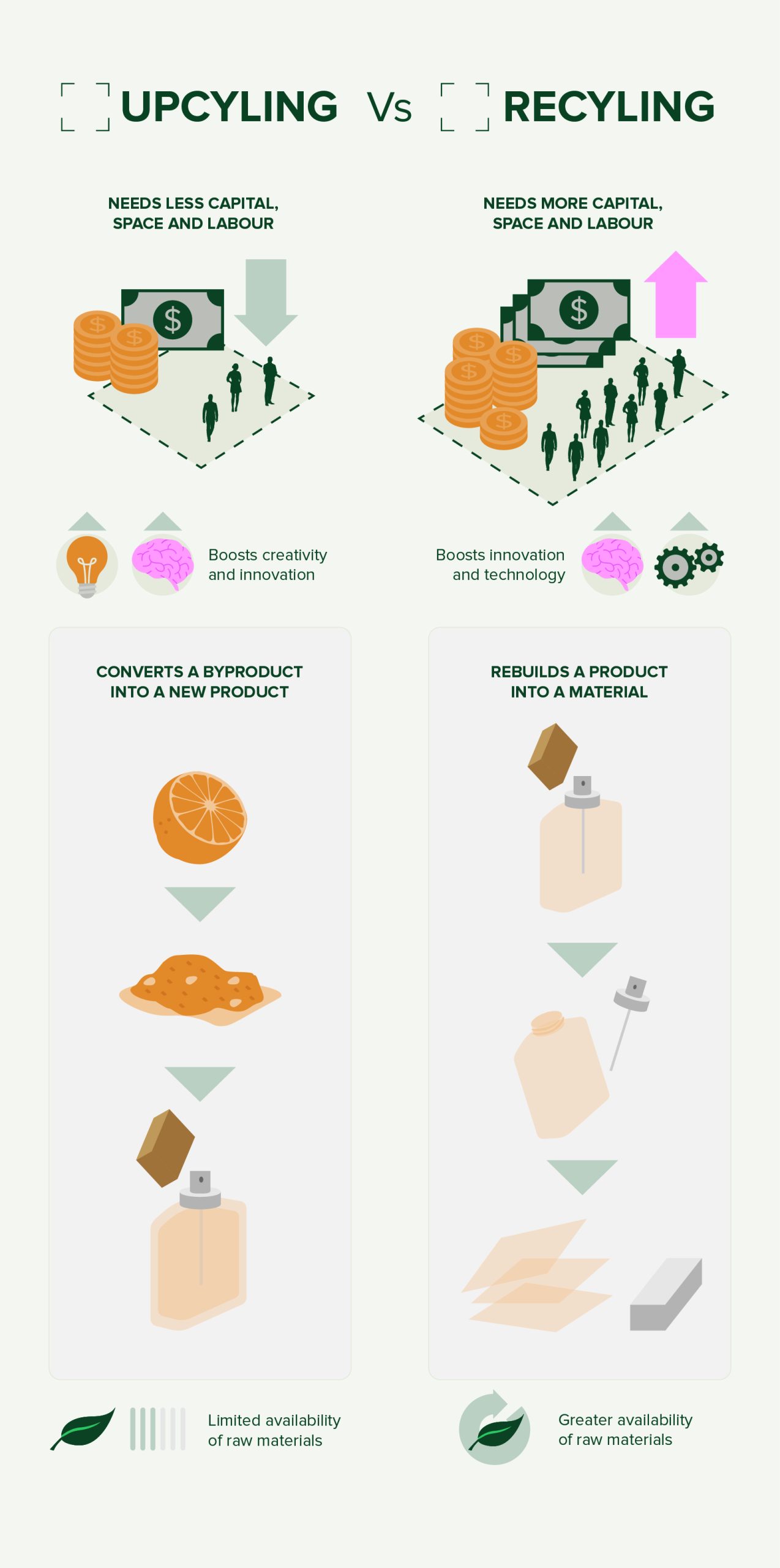Upcycled Fragrances: Breathing New Life into Traditional Waste Materials

Upcycling is not a new concept. From fashion to furniture industries, upcycling is being embraced to breathe new life into byproducts that would usually be discarded to give them new purpose and extend their life span. However what about upcycling in the fragrance industry?
With more than 1/3 of consumers choosing beauty brands based on environmental practices and values (1). It is important brands are innovating with sustainability in mind, taking reduce, reuse, and recycle to the next level. By prioritising zero waste principles and circular beauty, upcycling has been adopted as a creative way to meet the demands of these conscious consumers – but what exactly is upcycling and how is it used in the fragrance industry?
What is upcycling?
Upcycling is creative reuse that involves transforming by-products, waste materials, or useless products into innovative materials or products of better quality that have greater use than before (2,3).
This rejuvenation ensures the resulting product is deemed higher quality and has better environmental value, ultimately valorising waste materials and contributing to the circular economy space.
What is the difference between upcycling and recycling?
Upcycling is the process of adapting, and ultimately upgrading, a byproduct from its current state, whereas recycling involves the destruction of the product or byproduct in order to create something new.
What is an upcycled fragrance? How are upcycled fragrances made?
In the context of perfumery, a 100% upcycled fragrance does not currently exist. Fragrances can be composed of upcycled raw materials and for convenience, these are referred to as upcycled fragrances.
These upcycled fragrances utilise notes derived from traditional waste materials that would usually be discarded, such as exhausted rose petals, fruit peel, or pulp and wood chippings. Instead of being sent to landfill, these ‘waste’ materials undergo further processing to release new aromas which are combined to create unique scents.
Upcycled fragrances can also utilise by-products from unrelated industries; reclaimed wood retrieved from old furniture can be exploited for its resinous, deep notes, adding complexity to a fragrance. Also, coffee grounds, which are commonly disposed of after brewing, can be utilized to produce earthy, bitter notes which when fused with sweet notes like vanilla or caramel can create warm, energising fragrances.
What are the benefits of upcycled fragrances?
Re-imagination of ingredients through upcycling introduces newfound olfactory potential and opens up a realm of new opportunities for perfumers as it expands their creative palette. Exposure to unfamiliar notes enables a fresh perspective and advances artistic expression as perfumers are inspired to bring novel olfactive solutions to life.
Fragrance creation which embraces upcycled ingredients also ensures we are innovating responsibly with the planet and its resources in mind. Transformation of pre-used raw materials into new olfactive solutions means waste in the supply chain is minimised and accordingly we can positively reduce the number of raw materials being sourced to aid the preservation of natural resources.
What are the cons of upcycled fragrances?
The primary concern with upcycled fragrances is that upcycled raw materials lack continuity as a constant supply chain is either limited or unavailable. This is because their creation is dependent upon the generation of the primary raw material first. If an excess of the primary raw material is produced or sourced to solely make this upcycled ingredient, then this is clearly an unsustainable practice and could result in more harm to the environment than good.
You can also learn more about separating myth from reality surrounding sustainable fragrances by one of our experts here.
How do upcycled fragrances impact sustainability?
Reclaiming ingredients through upcycling ensures fragrances can be created with a reduced environmental impact. By identifying waste as a valuable resource, it means we can continue to move away from a linear economy and transition into a circular economy, contributing towards the creation of zero-waste products.
In addition, using upcycled ingredients means the harvesting of new raw materials can be reduced, preventing the over-farming of natural ingredients, and preserving resources. With natural raw materials being pivotal to fragrance development, it is vital that we value their availability and don’t over-harvest, otherwise, there would be a detrimental impact on the future availability of these natural ingredients.
What is Iberchem doing in the realm of upcycled fragrances?
At Iberchem various aspects of sustainability drive each step of fragrance creation, and upcycling is no exception. Embracing the upcycling movement is essential as we support zero waste initiatives, ensuring 99% of total waste generated by Iberchem is recycled and recovered giving it a new lease of life.
“Upcycling is an exciting prospect for sustainable fragrance innovation,” says Guillaume Audy, Sustainability Director at Iberchem. “Creating responsible perfumes with responsible ingredients at their core has released a new wave of originality as we now experiment with new scents in our creative palette. Also, by reusing natural resources, we can help to further reduce our environmental impact supporting our progression towards a more circular economy.”
What are some examples of upcycled fragrances?
Luxury brand Etat Libre d’Orange was one of the first to release a fragrance containing upcycled ingredients into the market. Suitably named “I Am Trash”, the fragrance contains ingredients repurposed from the food industry waste, twice distilled rose petals, and sandalwood chips to create a fruity, floral yet earthy scent.
Salt Eau de Parfum by Ellis Brooklyn also utilises cardamom from leftover cardamom pods, cedarwood sawdust and chips from the furniture industry, and jasmine repurposed from religious ceremonies in India. The resulting fragrance is the perfect summer scent with tropical floral notes followed by woody warmth and musk.
Sustainability is a constantly evolving space as we continue to learn more and develop new innovative ways to actively contribute and make a meaningful difference through new olfactive creations. It is clear fragrances using upcycled raw materials offer a strong solution to aid regenerative innovation and satisfy conscious customer demands shaping the future of sustainable, circular fragrances.
(1) The Upcycled Beauty Company’s 2022-2023 Zero Waste Beauty Report
(2) https://wdo.org/glossary/upcycling
(3) https://sdgs.un.org/partnerships/upcycle-repurpose-and-make-demand-sustainable-fashionable-future

